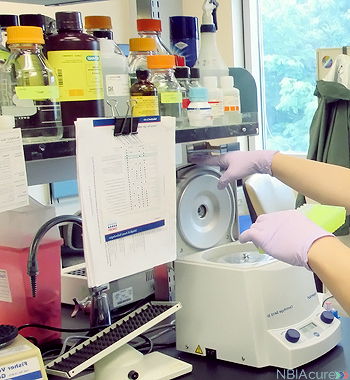To learn about DNA and genes, please read the Genetics page
 What Is Genetic Testing?
What Is Genetic Testing?
Genetic testing involves taking a DNA sample from an individual and analyzing the DNA to see if it contains any gene changes that are known to cause an NBIA disorder. Usually, a simple blood draw is used to obtain the DNA necessary for this process. Once the genetic testing lab receives a blood sample, DNA is extracted from the blood and then processed to create the quantity needed for testing. For NBIA disorders, two types of DNA analysis are used: sequence analysis and deletion/duplication analysis.
Sequence Analysis
The most commonly used method for NBIA disorders is sequence analysis. Sequence analysis involves going through the DNA, letter by letter, to see if there are any changes. It is a process similar to the “spell check” program on your computer that catches typos or spelling mistakes. The main difference is that the language of DNA is only made up of four letters (or bases): adenine (A), guanine (G), cytosine (C) and thymine (T). Sequence analysis reads through the individual letters of DNA and checks to see if there are any letters or words that are misspelled, in the wrong place, or missing or extra.
Deletion/Duplication Analysis
The majority of the time, sequence analysis is enough to find the gene change(s) that can confirm an NBIA diagnosis. However, if no gene changes or only one gene change (in the case of an autosomal recessive subtype) are found, then the lab can move forward to deletion/duplication analysis. Deletion/duplication analysis involves looking for sections of the DNA (or pages of the book) that are completely missing or duplicated in either one or both copies of a particular gene. Having a section of the gene missing or duplicated can disrupt how it works.
 Should siblings or relatives with no symptoms have genetic testing?
Should siblings or relatives with no symptoms have genetic testing?
If an individual is diagnosed with an NBIA disorder, one of the next steps is to decide whether other family members should also undergo genetic testing. If a sibling or other close relative has some symptoms of NBIA, then testing will likely be recommended. In many cases, if parents have a child newly diagnosed with an NBIA disorder, then they may have serious concerns about whether their other children could be affected.
Sometimes, doing a careful neurological examination first can help sort out whether testing should be considered in siblings. In other cases, parents are so concerned about their other children, especially if they are younger than the child with NBIA, that they may decide to pursue genetic testing just to be sure. Some genetic labs are not comfortable with testing children (or adults) with no symptoms, so finding someone who will do the genetic testing can be more difficult. Parents themselves may also struggle with the decision of testing children because they don’t want to put their children through unnecessary blood draws or the stress of waiting for results. Some of them may even choose to put off genetic testing until their child is old enough to make an informed decision.
One of the considerations to keep in mind when deciding whether to test children is if finding a diagnosis early will help improve the child’s care. In some cases, early detection can lead to improved outcomes because the child may start important medications earlier, is regularly monitored and observed for emerging symptoms, and can use physical and/or occupational therapy to maintain or enhance their quality of life. In addition, asymptomatic individuals who have a genetic diagnosis may have opportunities enroll in research trials and gain access to experimental medications or other treatments that may improve their outcomes.
When testing is done on healthy brothers and sisters, the family may learn that although one of their children does not have NBIA, he or she is a carrier. This will be important information for the child later in life, when family planning starts. However, discussing carrier status with children under 18 should be considered with care and caution since they will likely not be developmentally ready to discuss their reproductive futures.
Other adult family members may choose to sit down with a genetic counselor, go over the risks and benefits of testing, and make an informed decision about whether genetic testing is the right choice for them. For dominant neuroferritinopathy, individuals could be considering whether they want to know early that they will develop this adult-onset NBIA disorder. However, since most types of NBIA are recessive, the majority of healthy adults do testing to find out whether they are carriers of one of the gene changes found in their family member. They usually want this information for family planning.
Informing family members and coordinating testing
After at-risk relatives have been identified, the next step is to inform them of their risk so they can make their own decision about genetic testing. The most commonly used method is to send at-risk relatives a letter that explains the genetic change that was found in the individual with NBIA, what the diagnosis means and why genetic testing may be beneficial for them. Genetic counselors often help draft these family letters and can help coordinate the testing of family members by meeting with them or referring them to genetic counselors in their local area.
Where is NBIA genetic testing done?
Genetic testing of the following NBIA disorders is available through the OHSU Knight Diagnostic Laboratories. Click the links below to go to the page for each test.
- NBIA Sequencing Panel
- NBIA Deletion/Duplication Panel
- NBIA Sequencing AND Deletion/Duplication Panel
- PKAN Sequencing
- PKAN Deletion/Duplication
- PKAN Sequencing and Deletion/Duplication
- PLAN Sequencing
- PLAN Deletion/Duplication
- PLAN Sequencing and Deletion/Duplication
- FAHN Sequencing
- BPAN Sequencing
- MPAN Sequencing
- Neuroferritinopathy Sequencing
Family planning
One of the first tests done after the diagnosis of NBIA is genetic testing of the affected child’s parents. This testing will help confirm, in most cases of autosomal recessive NBIA, that the child inherited gene changes from both parents, who are carriers. If the genetic change was inherited from the parents, they have an increased chance of having another child with that gene change. Even in the case of new gene changes, such as in BPAN, families may want extra reassurance that it is not likely to happen again in a future pregnancy. There are a few testing options that are available to couples who have an increased risk of having a child with an NBIA disorder.
 Prenatal Testing
Prenatal Testing
Once a couple is pregnant, they may choose have either an amniocentesis or a CVS to find out if the developing fetus has the NBIA disorder in their family. Prior to testing, they should have genetic counseling to learn about all the options, risks and benefits. Following counseling, some couples may choose to do nothing while others will elect to do specialized testing.
A CVS (chorionic villus sampling) is done between 10 to 14 weeks of pregnancy. During a CVS, a doctor removes a small piece of tissue from the placenta. Since the placenta and the baby both develop from the fertilized egg, the DNA of the placenta can be used in place of the developing baby’s DNA for genetic testing. The placental DNA can be analyzed in the genetics lab to determine if the fetus has the same NBIA-causing gene change(s) seen in the family.
An amniocentesis is done between 15 to 20 weeks of pregnancy. During an amniocentesis, a doctor removes a small amount of fluid from the sac around the developing fetus. The procedure is done under the guidance of ultrasound so the doctor knows where the baby is at all times and can insert the needle in a pocket of fluid far away. The amniotic fluid contains skin cells that slough off the baby and can be used to extract DNA. The DNA is used by a genetics lab to determine if the baby has the same NBIA-causing gene change(s) seen in the family.
Deciding to test the developing fetus for a genetic disorder is a very difficult and personal decision. Some couples may want to do genetic testing so they don’t have to be worried for the entire pregnancy, wondering if they are going to have another child with NBIA. Other couples may want to know so they can prepare (emotionally and financially) if they are going to have a child with NBIA. In some cases, couples feel that it may be best to terminate an affected pregnancy.
Pre-Implantation Genetic Diagnosis
Some couples feel strongly that doing testing during pregnancy is too late. One option that is available to couples before they get pregnant is pre-implantation genetic diagnosis (PGD). PGD involves selecting and implanting only those embryos that do not have the NBIA-causing gene change(s) seen in the family. First, a couple must undergo fertility treatments and in vitro fertilization (IVF) to create multiple embryos during a single cycle/month. A small DNA sample is extracted from each embryo to figure out which ones carry gene changes that could cause NBIA. Once each embryo’s NBIA gene status has been determined, doctors can implant the embryos that are predicted to be healthy.
PGD is an expensive and invasive procedure that may not be the right choice for every couple. For some, however, it is most in line with their beliefs and is the preferred option.
Copyright © 2014 by NBIAcure.org. All rights reserved.